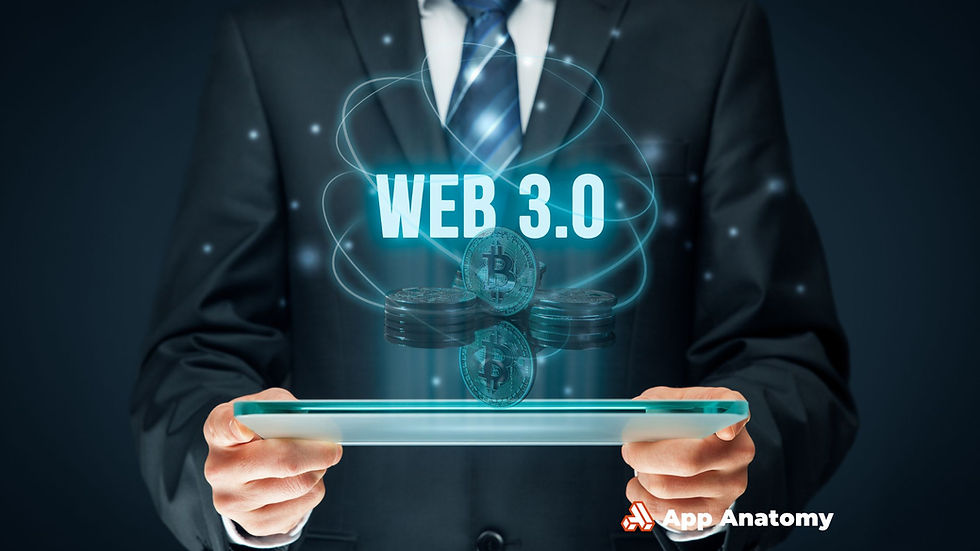Web3 and Decentralization: The Next Evolution of the Internet
- 3 days ago
- 4 min read

The internet is changing, again. We’ve gone from static websites in the early days (Web1) to interactive platforms controlled by tech giants (Web2). Now, a new vision is emerging: Web3.
Web3 is often described as a decentralized version of the internet, built on blockchain technology.
Instead of relying on big corporations to manage data, Web3 gives control back to users through smart contracts, decentralized apps, and token-based systems.
It’s not just a buzzword, it’s a growing movement that aims to reshape how we interact online.
What You Will Learn In This Article
How Web3 compares to Web2 and why decentralization matters
The core components of Web3 like dApps, smart contracts, and DAOs
What “owning your digital identity” actually means in a blockchain-powered internet
The benefits of Web3, including user control and transparency
Major challenges holding Web3 back today, from scalability to security
What the future may hold as Web3 continues to evolve in a Web2-dominated world
Web3 vs. Web2: What’s the Difference?
To understand Web3, it helps to know what it’s trying to improve.
Web2: The Era of Platforms and Power
Web2 is the internet you know today. It’s fast, interactive, and social. You can post videos, shop, scroll through feeds, and comment on pretty much anything.
But there’s a catch: most of it is owned and controlled by a few huge companies, like Google, Facebook (Meta), Amazon, and Apple.
These companies:
Store your data on their servers
Decide who sees your content
Profit from your online behavior
It’s convenient, yes, but it’s also centralized, meaning users have very little control over their own digital lives.
Web3: Decentralization, Ownership, and Openness
Web3 flips that model on its head. Instead of central platforms controlling everything, Web3 apps run on blockchains, decentralized networks where users own their data, identities, and even the platforms themselves.
Key features of Web3 include:
Decentralization: No single point of control
Token-based incentives: Users earn tokens for participating
User ownership: Data and assets stay with the individual
It’s about freedom, transparency, and community-driven development.
What Makes Web3 Work: Its Core Components
Web3 isn’t just a concept, it’s being built right now. And it’s made up of a few powerful tools.
Decentralized Applications (dApps)
dApps are like regular apps, but they don’t run on centralized servers. Instead, they’re powered by smart contracts and distributed across blockchain networks.
Uniswap (for crypto trading)
Audius (for music sharing)
Lens Protocol (for social networking)
Users interact directly with the app, no tech giant in the middle.
Smart Contracts: Code That Executes Itself
Smart contracts are like digital vending machines. You put in something (like a token), and they automatically do what they’re programmed to do, no middlemen needed.
They can:
Send payments
Trigger actions
Create decentralized rules
Smart contracts are the backbone of most Web3 applications.
DAOs: Community-Led Organizations
A DAO (Decentralized Autonomous Organization) is an online group that makes decisions together, usually by voting with tokens.
No CEO. No boardroom. Just a community managing itself transparently on the blockchain.
DAOs can govern:
Web3 platforms
Community funds
Even entire ecosystems
Digital Identity: You Own You
In Web2, your digital identity is scattered across platforms. In Web3, you can have a secure, blockchain-based identity that you own and control.
This could be used for:
Logging into apps
Controlling access to data
Proving who you are, without handing over personal info
It puts you in charge of your online self.
Why Web3 Matters: The Benefits and the Roadblocks
Like any new technology, Web3 has its pros and cons.
The Benefits
User Control: You own your data, assets, and identity.
Fewer Gatekeepers: No need to go through tech giants to launch or use an app.
Transparency: Everything on the blockchain is verifiable and public.
Community Power: DAOs give people a real say in decisions.
The Challenges
Scalability: Blockchain systems still struggle with speed and cost.
User Experience: Wallets, tokens, and dApps can be intimidating for newcomers.
Regulations: Governments are still figuring out how to handle decentralized platforms.
Security: Smart contracts can be buggy or hacked if not coded well.
Web3 isn’t perfect, but it’s improving fast.
What’s Next? Web3’s Future in a Web2 World
Web3 is still growing and it hasn’t replaced Web2 (yet). But it’s becoming more visible and more usable every year.
Big companies are exploring it. Developers are building it. And users are slowly starting to care more about control and privacy.
The next big step? Interoperability, where different blockchains and dApps can work together seamlessly. When that happens, Web3 could start feeling more like the everyday web, just more open, secure, and user-first.
Can Web3 Really Redefine the Internet?
Web3 is more than just a tech trend, it’s a vision for a better, fairer internet. One where you own your identity, you control your data, and you’re rewarded for your participation.
But it’s still early. The tools are being built. The rules are still forming. And the challenge of making Web3 as easy and accessible as Web2 is still ahead.
The question is: Will Web3 overcome its challenges to become the new standard, or remain a niche movement?
Time and the users, will decide.





Comments